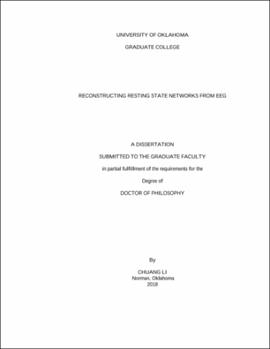| dc.description.abstract | Resting state networks (RSNs) have been found in human brains during awake resting states. RSNs are composed of spatially distributed regions in which spontaneous activity fluctuations are temporally and dynamically correlated. In contrast to task-related brain activities, RSNs reflect intrinsic functional organizations and rhythms of the human brain when it is not engaged in any task and/or disturbed by external stimuli. To date, RSNs have been widely studied using functional magnetic resonance imaging (fMRI), which has identified various RSNs associated with different brain functions. More recently, due to the advantage of millisecond temporal resolution, both electroencephalography (EEG) and magnetoencephalography (MEG) have been used to investigate RSNs and their electrophysiological underpinnings. Despite these advantages, current RSN studies using EEG/MEG, as compared with those using fMRI, are still at their infant stage in many aspects, such as the quality of spatial pattern reconstructions and the reliability of detections. These limitations require further studies to obtain accurate reconstructions of RSNs directly from EEG/MEG data.
My research aims to develop, optimize, and validate a variety of computational and analytical frameworks to reconstruct and investigate RSNs based on EEG data. In this dissertation, several studies have been conducted as outlined below. Firstly, a comparison in defining RSNs at the sensor space and at the source space was performed to evaluate the accuracy in reconstructing RSN spatial patterns. Results from both simulated and experimental data indicated that the analysis in the source space performed better in reconstructing various features of RSNs. Secondly, a new computational framework for reconstructing RSNs with human EEG data was developed. The proposed framework utilized independent component analysis (ICA) on short-time Fourier transformed inverse source maps imaged from EEG data and statistical correlation analysis to generate cortical tomography of electrophysiological RSNs. The proposed framework was validated using three sets of experimental data. The results indicated that the framework is reliable and efficient in the reconstruction of RSNs. Thirdly, an advanced inverse source imaging (ISI) method was used in the established framework discussed above to improve the spatial estimation of RSNs. The comparison between the new and conventional frameworks suggested that the ISI method significantly improved the accuracy of spatial estimations of RSNs. Fourthly, an ICA-based framework was used to assess RSN alternations under different conditions, which has been the model to identify imaging biomarkers, for example, for diseased patients as compared with healthy control. The results from both simulated and experimental data indicated that the framework could detect RSN alternations due to condition differences. My results further suggest that the framework could provide a finer resolution in detecting RSN changes as a contrast for multi-level (more than 2) condition differences, which can be used to study the difference, for example, among patients with a long history of a certain disorder, a short history, and healthy control. Overall, the findings of this dissertation study provided insights into the underlying electrophysiological basis of RSNs. More importantly, this study developed new frameworks that can be used as powerful tools for future investigations of more characteristics of RSNs, in particular for those not available in fMRI, e.g., spectral patterns. | en_US |
